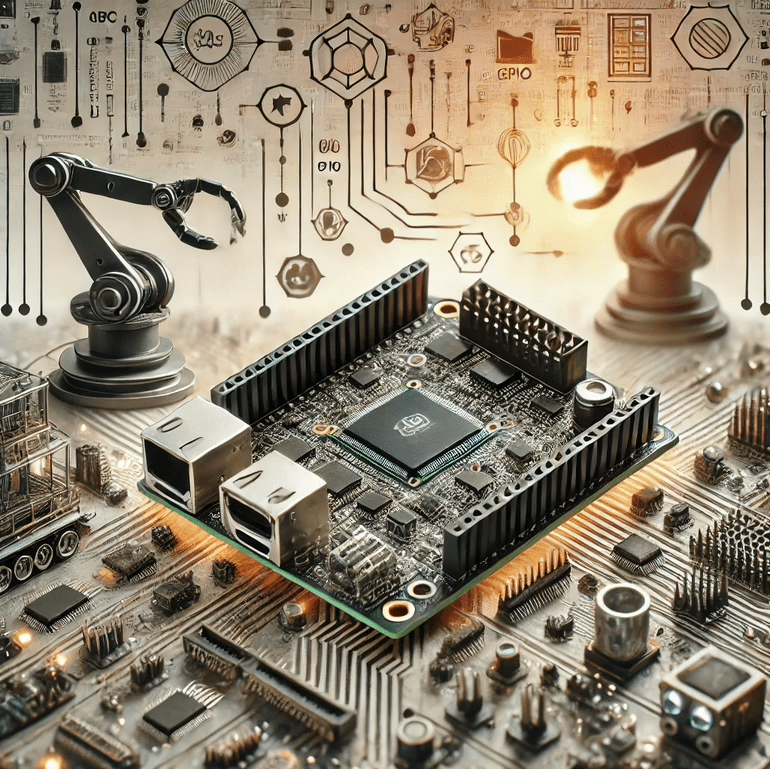In the ever-evolving world of technology, single-board computers (SBCs) have become essential tools for developers, hobbyists, and educators. These compact, versatile devices empower users to create and innovate, bridging the gap between software and hardware in countless applications. Among the most prominent SBCs on the market today is the BeagleBone series, developed by the BeagleBoard.org community. Known for its open-source philosophy, expandability, and flexibility, BeagleBone offers a unique platform for embedded computing projects.
In this article, we’ll explore the key features of BeagleBone, its applications, and how it compares to other SBCs like the Raspberry Pi. Additionally, we’ll highlight how Curate Consulting Services can assist businesses in finding specialized talent to maximize the potential of BeagleBone in their projects.
The Rise of Single-Board Computers in Embedded Systems
The concept of a single-board computer is not new, but its significance has grown exponentially in recent years. SBCs are complete computers on a single circuit board, equipped with a microprocessor, memory, storage, and various I/O ports. They offer an affordable and accessible platform for a wide range of applications, from simple DIY electronics projects to complex industrial automation systems.
The popularity of SBCs like the Raspberry Pi has made embedded computing more approachable for people of all skill levels. However, while the Raspberry Pi has become the go-to choice for many, the BeagleBone series has carved out its niche by emphasizing open-source hardware, expandability, and robust community support.
What is BeagleBone?
BeagleBone is a series of open-source SBCs developed by the BeagleBoard.org Foundation. It was created to provide an affordable and flexible platform for embedded computing enthusiasts, educators, and professionals. BeagleBone boards are similar in concept to the Raspberry Pi but offer distinct features that make them particularly well-suited for certain applications.
Key Features of BeagleBone
Single-Board Computer:
BeagleBone is a complete computer system on a single board, integrating a microprocessor, RAM, storage, and various I/O components. This design makes it a standalone device capable of running operating systems and executing complex tasks.Processor:
BeagleBone boards typically use ARM-based processors from Texas Instruments. These processors are known for their efficiency and performance, with different models offering varying levels of processing power to cater to diverse project needs.RAM:
The amount of RAM on a BeagleBone board can vary depending on the model. RAM is crucial for running applications and processing data, making it an essential component for embedded systems that require real-time performance.Storage:
BeagleBone boards use microSD cards for storage, similar to other SBCs like the Raspberry Pi. This flexible storage solution allows users to choose the capacity that best suits their projects, whether it’s a lightweight application or a data-intensive task.I/O Ports and Headers:
One of the standout features of BeagleBone is its extensive I/O options. These boards offer a variety of ports, including USB, HDMI or DisplayPort for video output, audio jacks, and Ethernet ports. Additionally, BeagleBone boards feature headers that expose GPIO pins, enabling users to connect and control external devices, sensors, and actuators.Cape Expansion:
A unique aspect of BeagleBone is the concept of “Capes.” Capes are expansion boards that can be stacked onto the BeagleBone, adding new hardware features or functionality. This modular approach allows users to customize their BeagleBone for specific applications, making it a highly versatile platform.Operating System:
BeagleBone supports a variety of operating systems, including Debian-based distributions and others tailored for embedded computing. This flexibility allows users to choose the OS that best fits their needs and preferences.Community and Documentation:
BeagleBone benefits from an active and engaged community of users and developers. The community contributes to extensive documentation, tutorials, and forums, making it easier for new users to get started and for experienced developers to find support.Applications:
BeagleBone is suitable for a wide range of applications, from robotics and home automation to industrial control and educational projects. Its flexibility and expandability make it a go-to choice for developers who need a customizable platform.Open-Source Hardware:
BeagleBone is built on open-source hardware principles, meaning that its specifications are freely available. Users can modify and share the designs, contributing to the collaborative and innovative nature of the platform.
BeagleBone vs. Raspberry Pi: Choosing the Right SBC
While the Raspberry Pi is often seen as the default choice for SBC projects, BeagleBone offers several advantages that make it the preferred option for certain use cases. Here’s how the two platforms compare:
Expandability and Customization
- BeagleBone: The Cape expansion system allows users to add specific features and functionalities to their BeagleBone boards, making it highly customizable for specialized applications.
- Raspberry Pi: While the Raspberry Pi has a wide range of HATs (Hardware Attached on Top) available, BeagleBone’s Capes offer a more integrated and modular approach to expansion.
I/O Capabilities
- BeagleBone: BeagleBone boards provide a broader range of I/O options, including a higher number of GPIO pins, which makes them ideal for complex embedded systems that require extensive interfacing with external components.
- Raspberry Pi: The Raspberry Pi also offers GPIO pins, but with fewer options and less flexibility compared to BeagleBone, which can be a limitation for more demanding projects.
Processing Power
- BeagleBone: Depending on the model, BeagleBone boards can offer varying levels of processing power, with some models designed for high-performance applications.
- Raspberry Pi: The Raspberry Pi 4, with its quad-core processor, is more powerful than most BeagleBone models, making it a better choice for tasks that require significant computational resources.
Community and Support
- BeagleBone: BeagleBone has a dedicated community that focuses on open-source development and embedded systems. The documentation and resources available are extensive, but may require a higher level of technical knowledge to fully utilize.
- Raspberry Pi: The Raspberry Pi community is larger and more diverse, with a wealth of resources available for beginners and experts alike. It’s often the better choice for those new to SBCs.
Cost
- BeagleBone: BeagleBone boards are generally priced higher than Raspberry Pi boards, reflecting their advanced features and capabilities.
- Raspberry Pi: Raspberry Pi is known for its affordability, making it accessible to a wide audience, including educators and hobbyists.
Applications of BeagleBone
BeagleBone’s versatility makes it suitable for a wide range of applications, particularly in areas where flexibility, expandability, and open-source principles are valued. Here are some examples:
Robotics
BeagleBone is a popular choice for robotics projects due to its extensive I/O capabilities and real-time processing features. Developers can connect multiple sensors, motors, and actuators, making it possible to build sophisticated robotic systems. The modular Cape system also allows for easy integration of additional hardware, such as motor controllers or sensor arrays.
Home Automation
With its ability to interface with various sensors and control systems, BeagleBone is well-suited for home automation projects. Users can create custom solutions for controlling lighting, heating, security systems, and more. The onboard Ethernet port and support for wireless communication make it easy to connect BeagleBone to a home network for remote control and monitoring.
Industrial Control
BeagleBone’s robustness and expandability make it an excellent choice for industrial control applications. It can be used to monitor and control machinery, process data from industrial sensors, and automate complex systems. The open-source nature of BeagleBone allows for customization to meet specific industrial requirements, ensuring that the system can adapt to the needs of the application.
Educational Projects
BeagleBone is also widely used in educational settings, where its open-source hardware and software provide a hands-on learning experience for students. Educators can use BeagleBone to teach concepts in embedded systems, electronics, and programming, allowing students to explore the fundamentals of computing in a practical context.
Curate Consulting Services: Finding Specialized Talent for Your BeagleBone Projects
As the demand for embedded systems and IoT solutions continues to grow, finding the right talent to develop and implement these technologies is more important than ever. At Curate Consulting Services, we specialize in connecting businesses with top-tier talent who possess the skills and experience needed to leverage platforms like BeagleBone.
Expertise in Embedded Systems
Our team understands the complexities of embedded systems development, including hardware design, firmware programming, and system integration. We have a network of professionals who are experienced in working with BeagleBone and other SBCs, ensuring that your projects are in capable hands.
Customized Staffing Solutions
Every project is unique, and so are its staffing needs. We offer customized staffing solutions that can be tailored to your specific requirements. Whether you need short-term contractors for a particular task or full-time employees for ongoing development, we can help you find the right talent.
Supporting Innovation
Innovation is at the heart of what we do. By connecting you with specialized talent, we enable your business to stay ahead of the curve in the rapidly evolving field of embedded computing. Whether you’re developing a new product, automating industrial processes, or exploring IoT applications, we’re here to support your success.
Conclusion: Empowering Innovation with BeagleBone and the Right Talent
BeagleBone offers a powerful and flexible platform for embedded computing, making it a valuable tool for developers, hobbyists, and educators alike. Its open-source nature, expandability, and extensive I/O capabilities set it apart from other SBCs, making it the ideal choice for a wide range of applications.
However, the success of any project depends not just on the technology, but on the people who bring that technology to life. At Curate Consulting Services, we’re committed to helping you find the specialized talent you need to turn your ideas into reality. Whether you’re building a robotic system, automating a factory, or teaching the next generation of engineers, we’re here to help you succeed.
Contact us today to learn how we can support your BeagleBone projects and help you achieve your goals in the world of embedded computing.



